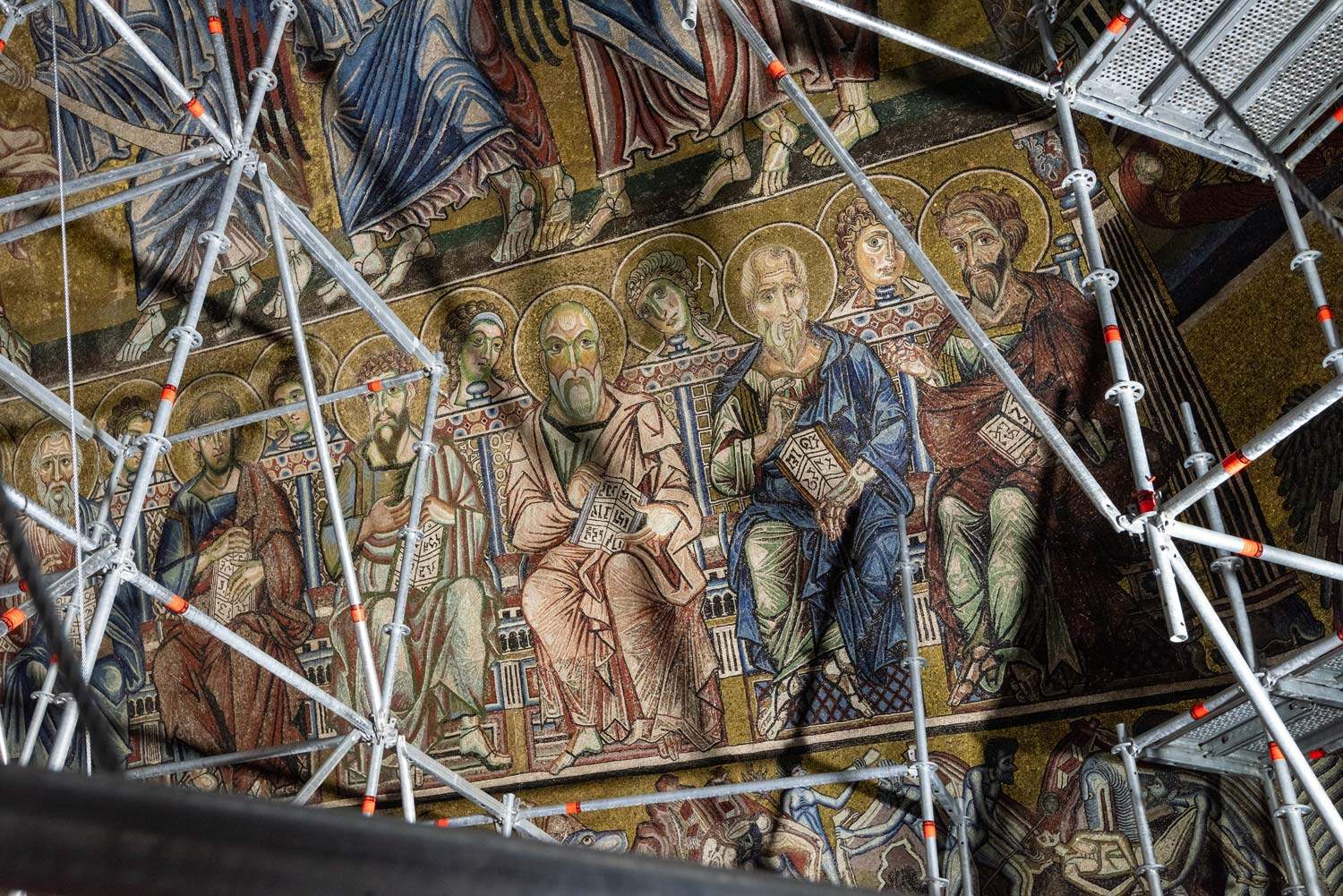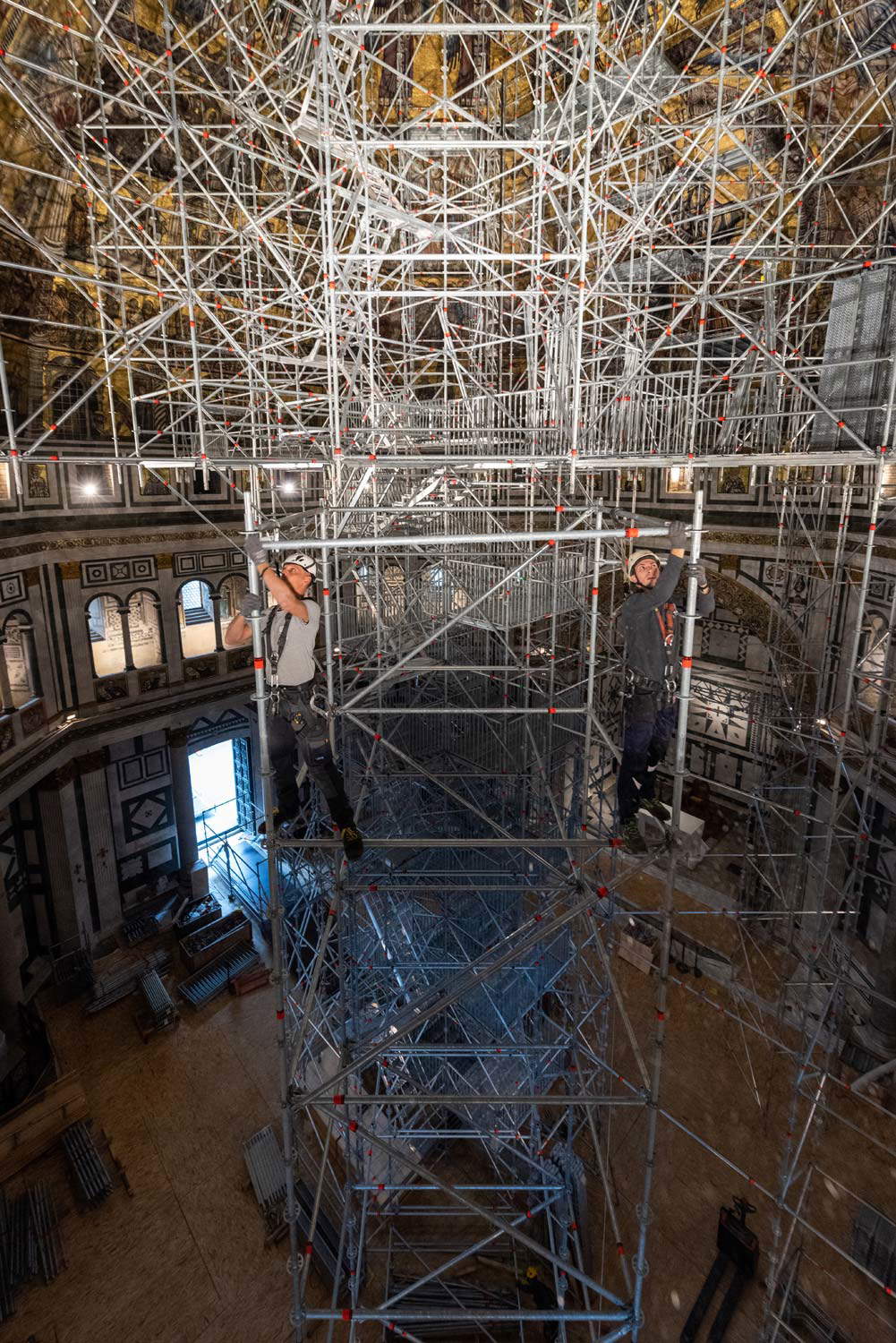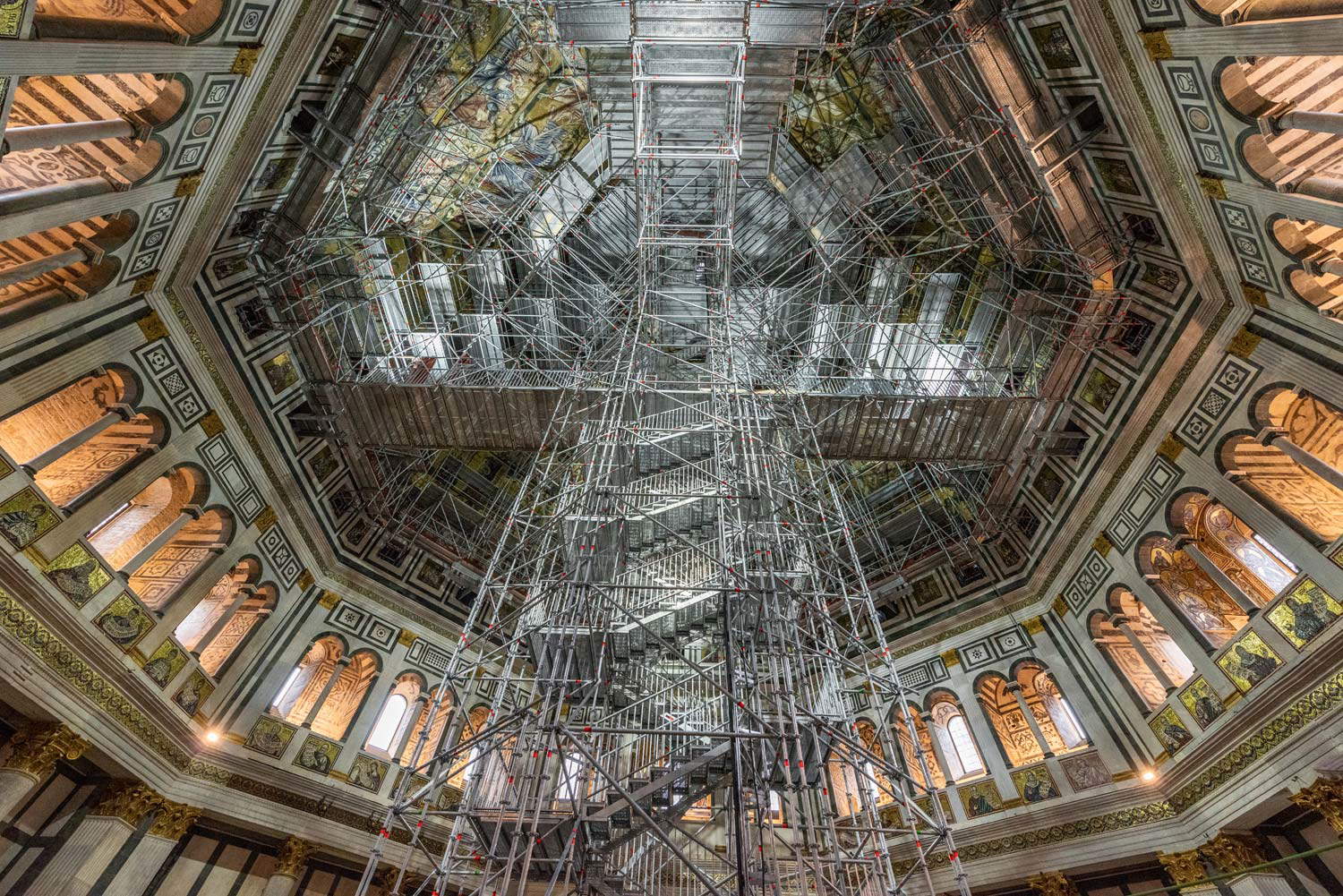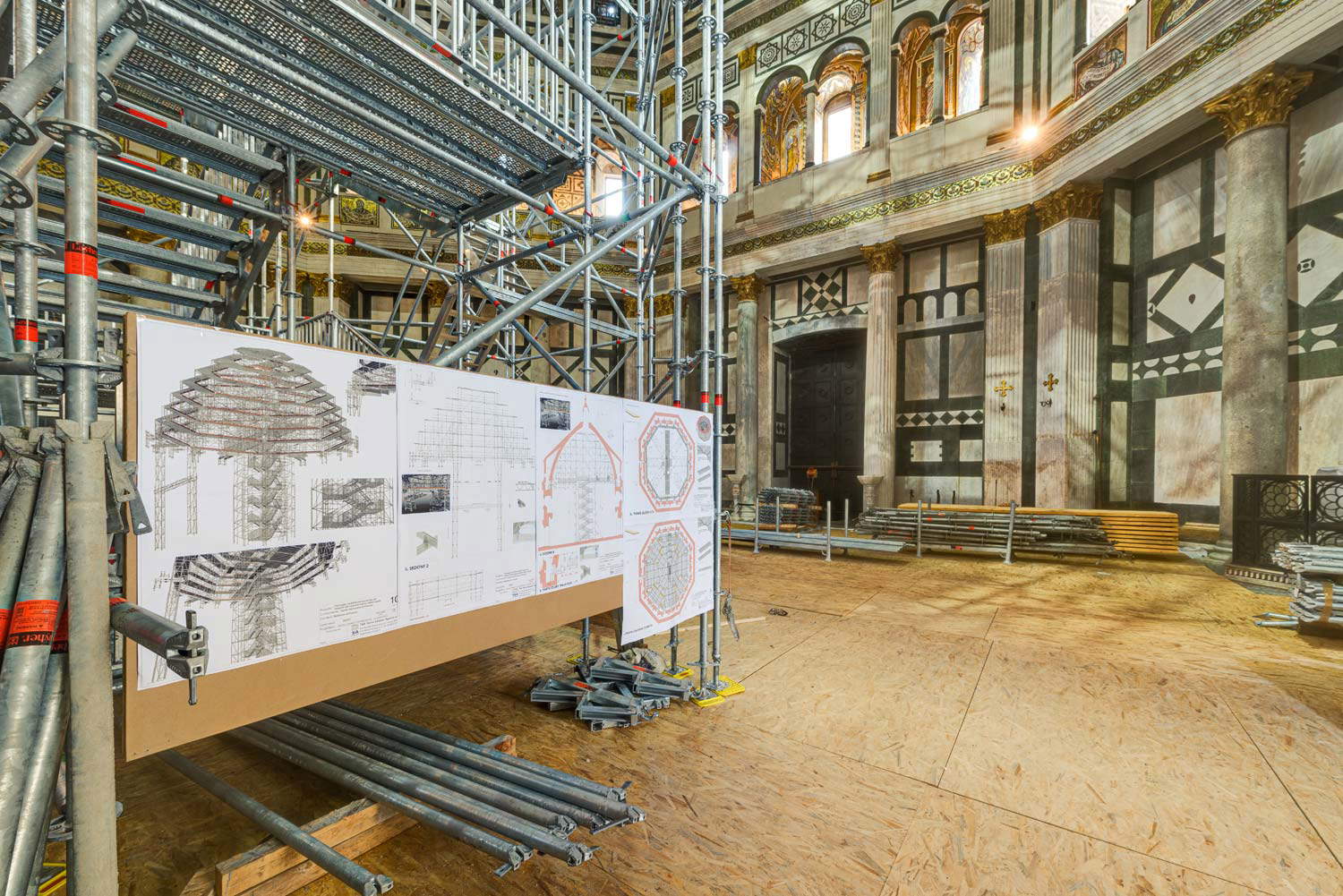In Florence , the restoration of the polychrome mosaics with a gold background of the Baptistery dome kicks off: an intervention that will last six years (work is expected to be completed by 2028), but will allow the public to see the grandiose cycle up close. In fact, the construction of the massive building site that will allow the restoration of the magnificent 13th-century mosaics has been completed. After more than 100 years since the last restoration in 1898-1907, the more than 1,000 square meters of mosaics in the Baptistery of St. John, made of 10 million polychrome tesserae ranging in size from 5 to 20 millimeters per side, will be the subject of an intervention that aims to recover their structural stability and adhesion to the vault, arrest the phenomena of degradation, and bring to light the splendor of the gold background and the vivid colors of the glass tesserae.
For thefirst time, as anticipated, it will be possible for the public to see up close the mosaics of the dome, made from preparatory drawings by artists such as Cimabue and Coppo di Marcovaldo, which on either side of the grandiose scene of the Last Judgment narrate on four registers the Stories of Genesis, Joseph the Jew, Christ and the Baptist. This is a unique and unrepeatable experience that will only be possible during the years of restoration. Visits will begin next February 24, 2023, by booking on the Opera’s website. The construction site and restoration work are commissioned and financed by the Opera di Santa Maria del Fiore in agreement with the Archdiocese of Florence, under the high supervision of the Soprintendenza Archeologia, Belle Arti e paesaggio for the Metropolitan City of Florence and the provinces of Prato and Pistoia. The construction site is a project of the Opera di Santa Maria del Fiore with Tecno System Appalti and Layher S.p.A. while the intervention was entrusted to the Archaeological Conservation Center, which among its many restored mosaic masterpieces boasts the celebrated ones from the Monastery of St. Catherine on Mount Sinai. The Opera starting in 2014 restored first the exterior of the monument and then the interior parts with mosaics, financing the work with 4.6 million. It will invest as much for the restoration of the mosaics of the dome, totaling 10 million euros.
In order to be able to restore the mosaic vault of the Florence Baptistery, it was necessary to design and build a technologically innovative construction site capable of making the entire mosaic surface of the vault accessible and at the same time having the least visual impact on the ground, thus leaving visible to visitors (1 million 215 thousand in 2022 alone) the walls and the scarsella decorated with marbles and mosaics, the restoration of which was completed in July last year. After a long gestation period, the solution identified was to build a mushroom-shaped scaffold (31.50 meters high and 25.50 meters in diameter), constructed in forty days, covering an area of 618 walkable square meters at the top, compared with an occupied area on the ground of only 63 square meters. The scaffolding, built with 8,150 elements, uses the latest generation of aluminum beams (Layher Flex), which, passing through the quadrangular openings facing the attic floor of the Baptistery, allow the loads to be evenly distributed over the monument’s load-bearing structure.
The restoration of the mosaic dome of the Baptistery of Florence, which no one has been able to examine and study closely for more than a century, will be able to take advantage of the experience gained in the previous restoration of the interior walls of the Baptistery and of the information acquired on past restorations and in particular that of 1898 - 1907 carried out by theOpificio delle Pietre Dure. It is assumed, on the basis of the latter’s final report, that the intervention will have to deal with a situation that presents a surface area of 344 square meters of ancient mosaic, bedded on original mortar, probably in the process of detachment; 567 square meters of detached mosaic surfaces and repointed on cement mortar by theOpificio; 128 square meters of surfaces that fell and were treated with decorated plaster in the intervention of 1820 - 1823 and then remade in mosaic in the last restoration.
In these days the diagnostic investigations necessary not only to verify detachments or decohesion but also to define the degradation of the tesserae, the composition and the state of “health” of the different materials that make up the work will begin. Based on all the graphic, photographic and diagnostic information acquired, it will then be possible to outline in detail the specific intervention methodologies for each problem, identify the most appropriate and innovative materials and then proceed to the actual restoration.
Dominated by the figure of Christ the Judge, the mosaics of the Baptistery dome were a source of inspiration for the depiction of Hell in Dante’s Divine Comedy. Around 1225, according to the date inscribed in the Baptistery’s scarsella, work began, probably drawing on mosaicists who had come from outside and furnaces already active elsewhere. But soon the Florentine artists were able to gain full autonomy, and by the end of the century the more than 1,000 square meters of the dome had been cloaked in the glittering mosaic guise. Several generations of artists followed one another on the scaffolding to create a spectacular anthology of art, pictorial and mosaic at once, of which the vault of the scarsella is also a part, the mosaics of which were made while those of the dome were still being worked on. Once this colossal undertaking was completed, they wanted to extend them to the wall areas as well, where they were not originally planned.
 The
The The restoration site of the
The restoration site of the The restoration site of the
The restoration site of the The restoration site of the mosaics of the dome of the Baptistery
The restoration site of the mosaics of the dome of the Baptistery The restoration site of the mosaics of the dome of the Baptistery
The restoration site of the mosaics of the dome of the Baptistery The restoration site of the mosaics of the dome of the Baptistery
The restoration site of the mosaics of the dome of the Baptistery The restoration site of the
The restoration site of theFrom the archival research that proceeded the restoration project, news emerged documenting maintenance work starting as early as the 14th century, made necessary by water infiltration from the roof that had damaged the mosaics. We know that for the first intervention the artist Agnolo Gaddi was commissioned and subsequently, starting in 1483, the Opera assigned an annual income of thirty florins to the painter Alesso Baldovinetti to check the stability of the mosaics and intervene punctually where necessary. Over the course of the following centuries further maintenance work would be carried out, the most important of which would be that of 1781 - 1782 by Giovanni Orlandini and Giuseppe Sorbolini, which, however, was not useful because in already June 1819 a large section of the mosaics and painted plaster had detached.
It was thus decided to intervene again, painting the areas where the mosaics had fallen off, instead of redoing them in mosaic, and for this the painter Luigi Ademollo was commissioned, who worked on it from 1820 to 1823. Ademollo also used wide iron plates to fix the mosaics, a solution that proved completely ineffective so that by the end of the nineteenth century when the Opera commissioned the Opificio delle Pietre Dure, then headed by Superintendent Edoardo Marchionni, large areas of mosaic were imminent. Thanks to the Opificio’s final report, we know that 1032 square meters of the mosaic vault was restored. Of these, the 128 square meters that had fallen and were painted in plaster by Luigi Ademollo were redone in mosaic thanks to the cartoons of painter Arturo Viligiardi, using the old fallen tiles and some new ones ordered from Murano. Few of the other 911 square meters were adhered to the vault, and the Opificio decided to detach 567 square meters and realign them with a mortar containing a portion of slow-setting cement.
The restoration of the more than 1,000 square meters of mosaic decoration of the intrados of the vault of the Baptistery of San Giovanni required the construction of an imposing provisional work, as explained by Samuele Caciagli, architect of the Opera di Santa Maria del Fiore and single person in charge of the procedure-a scaffold conceived by the Technical Office of the Opera di Santa Maria del Fiore and TSA (Techno System Appalti di Roma), designed and calculated by the same Capitoline company. “The procedure for the design was concluded after a long gestation period that, after an initial selection of suppliers, carried out on the basis of the preliminary design and a concept, involved architects, company engineers and scaffolders, each for their specific skills,” Caciagli explained. “Nothing could be left to chance in the multiple revisions, everything had to be carefully calculated, measured, and designed so that implementation could proceed without any hindrance. Therefore, we started from the three-dimensional survey of the entire volume of the Baptistery, a survey carried out by the University of Florence in 2014 that allowed us to identify with precision and correctness the possible anchorage points, the development of the work planes, and the correct location of the storage areas. Having identified the architectural and structural constraints, these were passed on to the various participants in the selection process for the design and erection assignment with the request to formulate all possible organizational and design improvements, in compliance with the regulations and always under the careful observation of the manufacturer of the materials, Layher S.p.a, who supervised the activity and assisted the client in a proactive and proactive way.”
The objective, Caciagli explains, was “to create a large provisional work that would make the entire mosaic surface accessible, while at the same time seeking a structure whose overall weight would not weigh too heavily on the monumental text of the beautiful St. John’s and its structures, based on the results of previous studies and especially those conducted for the last parietal restoration. At the same time it was considered essential to leave completely usable the wall surfaces decorated with marble and mosaics that had just been restored along with those of the scarsella and its vault. In order to do this, it was therefore necessary to devise and final and executive design of an innovative technically functional and technologically advanced structure that would draw inspiration from the now codified morphologies of the mushroom or umbrella.” The structure is therefore completed on time and on schedule and is now ready for its use: “to show the public the progress of the work and the details of a splendid cycle of mosaic decoration such as that of the vault, but above all for the work that will allow us to hand down this monumental testimony to future generations in full compliance with the principles of restoration.”
The realization of this construction site was a real feat for so many reasons: the design solution, made possible by appropriate insights and technological solutions, the time required (only forty days of work to assemble and verify the more than 8000 metal elements that make up the structure), the fact that the scaffolding is safe and accessible.
The restoration itself, then, is configured as an undertaking of great scope and importance, again for various reasons, as Beatrice Agostini, Designer and Director of Restoration Works explains: “notoriety of the work, grandeur of the site, high specialization required by the work, innovative contribution to the knowledge of the history and technique of a work of capital importance and that for over a century no one has been able to examine and study closely.” Each case history presented will have to be treated differently, especially with regard to consolidation work; “fundamental,” Agostini points out, “was the restoration of the scarsella in which we were confronted with detached elements and realluted on cement mortar of the same type as that of the dome by Marchionni (superintendent of the Opificio delle Pietre Dure and director of the late 19th-century restoration work). The necessary restoration work will be preceded by a series of diagnostic analyses aimed at determining the state of conservation of the mosaics, especially investigations with ultrasound, georadar and thermography will be carried out, so as to define the actual stability of the mosaics but also investigations through the pacometer for the detection of pins and brackets as well as non-invasive investigations such as XRF2, UV, visible and grazing light images. It will also be necessary to proceed with a diagnostic campaign to characterize the previously used mortars both to define the consolidation methods and products and to create a chronological order of the various interventions and identify them precisely in specific tables. The diagnostic campaign is necessary not only to check for detachments or decohesion but also to define the degradation of the tesserae and the composition and health of the different materials that make up the work. In addition, of fundamental importance will be the execution of mappings of the parts reallected by Marchionni for which the original mappings present at the Opificio delle Pietre dure should also be consulted. On the basis of all the graphic, photographic and diagnostic information it will be possible to outline in detail the specific intervention methods for each problem, identify the most appropriate and innovative materials and then proceed to the actual restoration.”
The current conservation situation of the mosaics appeared significant along the edges of the dome where large cracks rise up where the mosaics have opened. The loss in these areas of the continuity of the mosaic fabric consequently makes the neighboring parts precarious. Also worthy of attention are the various depressions on the vault, visible even to the naked eye, which suggest detachments from the underlying structure. The final objective of the intervention is, Agostini concludes, “to recover the structural stability of the mosaics and their adhesion to the vault, to arrest the degradation phenomena in progress and to restore the integrity of the surface. Finally, it will be the cleaning intervention that will bring back the splendor of the gold background and the vivid colors of the glass tesserae. The restoration will involve cleaning the entire tessellated surface, consolidating the areas of mosaic that are unsafe and adhering them to the underlying structure, consolidating the vitreous and stone tesserae, filling in the gaps, and suturing the cracks that have opened in the mosaic along the edges of the octagonal dome. Important will be the structural verification of the Baptistery itself, which will necessarily involve work not present and conceivable.”
“The Opera di Santa Maria del Fiore,” explains President Luca Bagnoli, “was born to build the Cathedral of Florence and administer the assets dedicated to its maintenance. The subsequent evolution, crystallized in the concordat norms, on closer inspection assigns two purposes: an explicit, primary one, since we are dealing with churches, that of maintaining the buildings in the service of worship; an implicit one, that of maintaining them as cultural assets of interest to the entire community, as the cultural heritage of humanity. The restoration of the mosaics of the Baptistery’s dome fully responds to these purposes and represents the continuation of a commitment that began in 2014 and which will end in 2028.”
“For centuries the Opera di Santa Maria del Fiore has had the care of the Baptistery and the Cathedral, which are the places the one of the source of Christian life, baptism, and the other the culmination of Christian life the Eucharist,” says Cardinal Giuseppe Betori. “All this our fathers wanted in the sign of beauty, so that through it was also expressed the Truth of the mystery that is celebrated here and that is the fact that here God meets man. That is why in the Baptistery on the one hand there is the unfathomable mystery of God represented in some way by the geometric forms in the marbles, the maximum of abstraction, of transcendence, and on the other hand the fact that our religion is an embodied religion made up of bodies, that of Christ, that of the men who believed in him, faces, figures that we find represented in the mosaics of the gallery and that triumph in those of the dome. The Baptistery is a building that says the Christian specific, so taking care of it is not only about aesthetics, here the beautiful leads to the True, the restoration of the mosaics is therefore a valid work for faith and not only for art history.”
 |
| Florence, restoration of the mosaics of the Baptistery dome begins |
Warning: the translation into English of the original Italian article was created using automatic tools. We undertake to review all articles, but we do not guarantee the total absence of inaccuracies in the translation due to the program. You can find the original by clicking on the ITA button. If you find any mistake,please contact us.